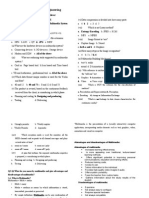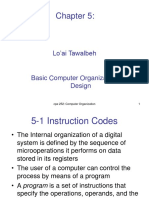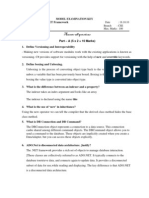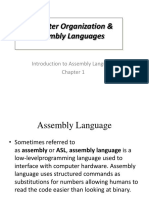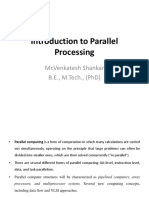Chapter 1 - Introduction To Multimedia
Chapter 1 - Introduction To Multimedia
Uploaded by
gcrossnCopyright:
Available Formats
Chapter 1 - Introduction To Multimedia
Chapter 1 - Introduction To Multimedia
Uploaded by
gcrossnOriginal Title
Copyright
Available Formats
Share this document
Did you find this document useful?
Is this content inappropriate?
Copyright:
Available Formats
Chapter 1 - Introduction To Multimedia
Chapter 1 - Introduction To Multimedia
Uploaded by
gcrossnCopyright:
Available Formats
MEKELL UNIVERSITY
SCHOOL OF COMPUTING
Multimedia
Introduction to Multimedia
1.1 Overview of Multimedia:
Multimedia can have a many definitions these include:
Based on the word ―Multimedia‖. It is composed of two words:
Multi- multiple/many
Media- source
Source refers to different kind of information that we use in multimedia.
This includes: (Text, Graphics/ Images, Audio, Video, animation)
Multimedia means from computer science point of view that computer information can be
represented through multiple modalities like audio, video, and animation in addition to
traditional media (i.e., text, graphics drawings, images).
A good general definition is:
Multimedia is the field concerned with the computer-controlled integration of text, graphics,
drawings, still and moving images (Video), animation, audio, and any other media where every
type of information can be represented, stored, transmitted and processed digitally.
A Multimedia Application is an Application which uses a collection of multiple media sources
e.g. text, graphics, images, sound/audio, animation and/or video.
Hypermedia can be considered as one of the multimedia applications.
Examples of Multimedia Applications
Digital video editing and production systems
Electronic Newspapers/Magazines
Games
Groupware
Home shopping
Compiled By: EshetieG. And Letezgi H. Page 1
Interactive TV
Education
o Computer Aided Learning (CAL)
o E-Learning (World Wide Web)
Video conferencing
Video-on-demand
Virtual reality
What is Multimedia system?
A Multimedia System is a system capable of processing multimedia data. A Multimedia System
is characterized by the processing, storage, generation, manipulation and rendition of multimedia
information.
Characteristics of a Multimedia System
A Multimedia system has four basic characteristics:
Multimedia systems must be computer controlled
Multimedia systems are integrated
The information they handle must be represented digitally
The interface to the final presentation of media is usually interactive(When the user is given
the option of controlling the elements)
Components of multimedia systems
1.2 History of Multimedia:
Newspaper was perhaps the first mass communication medium, which used mostly text, graphics,
and images.
In 1895, Gugliemo Marconi sent his first wireless radio transmission at Pontecchio, Italy. A
few years later (in 1901), he detected radio waves beamed across the Atlantic. Initially
invented for telegraph, radio is now a major medium for audio broadcasting. Television was
the new media for the 20th century. It brings the video and has since changed the world of
mass communications.
On computers, the following are some of the important events:
1945 -Vannevar Bush (1890-1974) wrote about Memex.
MEMEX stands for MEMory EXtension. A memex is a device in which an individual stores
all his books, records, and communications, and which is mechanized so that it may be
consulted with exceeding speed and flexibility. It is an enlarged intimate supplement to his
memory.
1960s-Ted Nelson started Xanadu project (Xanadu – a kind of deep Hypertext).
Project Xanadu was the explicit inspiration for the World Wide Web, for Lotus
Notes and for HyperCard, as well as less-well-known systems.
1967 - Nicholas Negroponte formed the Architecture Machine Group at MIT. A
combination lab and think tank responsible for many radically new approaches to
the human-computer interface. Nicholas Negroponte is the Wiesner Professor of
Media Technology at the Massachusetts Institute of Technology.
1968 - Douglas Engelbart demonstrated NLS (Online Systems) system at SRI.
Compiled By: EshetieG. And Letezgi H. Page 2
Shared-screen collaboration involving two persons at different sites communicating over a
network with audio and video interface is one of the many innovations presented at the
demonstration.
1969 - Nelson & Van Dam hypertext editor at Brown
1976 - Architecture Machine Group proposal to DARPA: Multiple Media
1985 - Negroponte, Wiesner: opened MIT Media Lab
Research at the Media Lab comprises interconnected developments in an unusual range of
disciplines, such as software agents; machine understanding; how children learn; human
and machine vision; audition; speech interfaces; wearable computers; affective computing;
advanced interface design; tangible media; object-oriented video; interactive cinema;
digital expression—from text, to graphics, to sound
1989 - Tim Berners-Lee proposed the World Wide Web to CERN (European Council for
Nuclear Research)
1990 - K. Hooper Woolsey, Apple Multimedia Lab gave education to 100 people
1992 - The first M-Bone audio multicast on the net (MBONE- Multicast Backbone) 1993
– U. Illinois National Center for Supercomputing Applications introduced NCSA Mosaic
(a web browser)
1994 - Jim Clark and Marc Andersen introduced Netscape Navigator (web browser).
1995 - Java for platform-independent application development.
1.3 Hypertext and Hypermedia
What is Hypertext and Hypermedia?
Hypertext is a text, which contains links to other texts. The term was invented by Ted Nelson
around 1965. Hypertext is usually non-linear.
Hypertext
Compiled By: EshetieG. And Letezgi H. Page 3
Hypermedia is not constrained to be text-based. It can include other media, e.g., graphics, images,
and especially the continuous media -- sound and video. Apparently, Ted Nelson was also the
first to use this term.
The World Wide Web (www) is the best example of hypermedia applications.
Hypertext
Hypermedia
Compiled By: EshetieG. And Letezgi H. Page 4
Hypermedia is the application of hypertext principles to a wider variety of media, including audio,
animations, video, and images. It is a combination of hypertext, graphics, audio, video, (linked
elements) and interactivity culminating in a complete, non-linear computer-based experience.
Examples of Hypermedia Applications:
The World Wide Web (WWW) is the best example of hypermedia applications.
PowerPoint
Adobe Acrobat
Macromedia Director
Application of hypertext concept to multimedia documents
Linking or embedding of multimedia objects
System components (e.g. Word-Wide Web)
Makeup language e.g. HyperText Markup Language (HTML)
Directory service e.g. Uniform Resource Locator (URL) communication protocols
HyperText Transfer Protocol (HTTP), File Transfer Protocol (FTP)
A Multimedia Project is identified as Non-Linear when:
It is interactive
Users have control over the content that is being showed to them.
Users are given navigational control
1.1 Challenges and Feautures Of Multimedia
Desirable Features for a Multimedia System
Given the above challenges, the following features are desirable for a Multimedia System:
1. Very high processing speed processing power. Why? Because there are large data to be
processed. Multimedia systems deals with large data and to process data in real time, the
hardware should have high processing capacity.
2. It should support different file formats. Why? Because we deal with different data types
(media types).
3. Efficient and High Input-output: input and output to the file subsystem needs to be efficient
and fast. It has to allow for real-time recording as well as playback of data. e.g. Direct to Disk
recording systems.
4. Special Operating System: to allow access to file system and process data efficiently and
quickly. It has to support direct transfers to disk, real-time scheduling, fast interrupt
processing, I/O streaming, etc.
5. Storage and Memory: large storage units and large memory are required. Large Caches are
also required.
6. Network Support: Client-server systems common as distributed systems common.
Compiled By: EshetieG. And Letezgi H. Page 5
7. Software Tools: User-friendly tools needed to handle media, design and develop
applications, deliver media.
Challenges of Multimedia Systems
1) Sequencing with in media
2) Synchronization issue: in MM application, variety of media are used at the same instance. In
addition, there should be some relationship between the media. E.g between Movie (video) and
sound. There arises the issue of synchronization.
3) Data conversion: in MM application, data is represented digitally. Because of
this, we have to convert analog data into digital data.
4) Compression and decompression: Why? Because multimedia deals with large amount of
data (e.g. Movie, sound, etc) which takes a lot of storage space.
5) Render different data at same time — continuous data.
* * * * *
Compiled By: EshetieG. And Letezgi H. Page 6
You might also like
- Kiosk Case StudyDocument43 pagesKiosk Case StudyLisha Agrawal100% (4)
- Motion-For Judgment On The PleadingsDocument3 pagesMotion-For Judgment On The Pleadingsjayson àrandia50% (2)
- Passages in Modern Sculpture (Rosalind E. Krauss) (Z-Library)Document324 pagesPassages in Modern Sculpture (Rosalind E. Krauss) (Z-Library)Willian NascimentoNo ratings yet
- Assignment 1Document9 pagesAssignment 1Walter WhiteNo ratings yet
- Module - 2: Dept., of CSE, BGSITDocument55 pagesModule - 2: Dept., of CSE, BGSITSiddhartha B S100% (1)
- Kebere Goshu: Bahir Dar UniversityDocument22 pagesKebere Goshu: Bahir Dar UniversityTadele Molla ታደለ ሞላ0% (1)
- Sample QuestionsDocument16 pagesSample QuestionsAditya jhaNo ratings yet
- Research Methods in Computer Science 1Document14 pagesResearch Methods in Computer Science 1eyob bitewNo ratings yet
- Bresenham Line Drawing AlgorithmDocument8 pagesBresenham Line Drawing AlgorithmYOGESHWAR SINGHNo ratings yet
- Multimedia Systems FinalDocument29 pagesMultimedia Systems FinalAnonymous PaUyyhf1OT100% (1)
- 117FM - Mobile Application Development PDFDocument8 pages117FM - Mobile Application Development PDFvenkiscribd444No ratings yet
- Chapter-4: Microprocessor: 8086 and Modern MicroprocessorsDocument50 pagesChapter-4: Microprocessor: 8086 and Modern MicroprocessorsPRABHAKAR MORENo ratings yet
- Lecture Wise Plan 2-V Computer Organization and Assembly Language IIIDocument4 pagesLecture Wise Plan 2-V Computer Organization and Assembly Language IIISofia RaoNo ratings yet
- Algorithm Analysis and DesignDocument83 pagesAlgorithm Analysis and DesignkalaraijuNo ratings yet
- Introduction To OOAD What Is OOAD? What Is UML? What Are The United Process (UP) PhasesDocument41 pagesIntroduction To OOAD What Is OOAD? What Is UML? What Are The United Process (UP) PhasesPushpavalli MohanNo ratings yet
- Software Construction Lecture 1Document30 pagesSoftware Construction Lecture 1AMJAD HUSSAIN ZAHIDNo ratings yet
- 502 Object Oriented Analysis and DesignDocument110 pages502 Object Oriented Analysis and DesignRekha JaiswarNo ratings yet
- Presentation 1Document18 pagesPresentation 1bekemaNo ratings yet
- 07 Unit 4Document32 pages07 Unit 4Hasrulnizam HashimNo ratings yet
- Hypertext and Multimedia in HciDocument15 pagesHypertext and Multimedia in HciAMALA MARIYANo ratings yet
- Assembly Language DDGDocument21 pagesAssembly Language DDGlloydmuya100% (3)
- Lecture 2 Fundamental Steps in Digital Image ProcessingDocument4 pagesLecture 2 Fundamental Steps in Digital Image ProcessingAaqib IhrazNo ratings yet
- Structured ProgrammingDocument17 pagesStructured ProgrammingujjwolNo ratings yet
- CH 3 Computer Hardware For Information SystemsDocument14 pagesCH 3 Computer Hardware For Information SystemsIzzabelle Athena JayoNo ratings yet
- Os LabDocument63 pagesOs LabsuriyakrishnanNo ratings yet
- Chapter 4 Concurrency Control TechniquesDocument41 pagesChapter 4 Concurrency Control TechniquesFiraol BonsaNo ratings yet
- Infrastructure of E CommerceDocument58 pagesInfrastructure of E CommerceReychel Rodriguez100% (1)
- CS1401 - Internet ProgrammingDocument15 pagesCS1401 - Internet ProgrammingChozha RajanNo ratings yet
- CH 10 Designing and ProducingDocument34 pagesCH 10 Designing and ProducingLintang Setyo KurniawatiNo ratings yet
- Distributed Systems Chapter 3-ProcessesDocument33 pagesDistributed Systems Chapter 3-ProcessesTolosa TafeseNo ratings yet
- 3 MM CompressionDocument35 pages3 MM Compressionermiyas100% (1)
- Laxmi Devi Institute of Engineering &technology: Chikani, AlwarDocument110 pagesLaxmi Devi Institute of Engineering &technology: Chikani, AlwarAshish Bhati100% (1)
- Chapter 2Document56 pagesChapter 2Ermias MesfinNo ratings yet
- Computer Networks NotesDocument7 pagesComputer Networks Notesishtiaq hussainNo ratings yet
- Prototyping The Physical Design For IoT DevicesDocument4 pagesPrototyping The Physical Design For IoT DevicesZia AhmedNo ratings yet
- COA - Chapter # 2Document60 pagesCOA - Chapter # 2Set EmpNo ratings yet
- Structured ProgrammingDocument42 pagesStructured ProgrammingAkendombi EmmanuelNo ratings yet
- Chapter 5 Basic Computer Organization and DesignDocument84 pagesChapter 5 Basic Computer Organization and DesignKulwinder Jeet SinghNo ratings yet
- Chapter 1 - Introduction To Wireless and Mobile ComputingDocument30 pagesChapter 1 - Introduction To Wireless and Mobile ComputingHuseinNo ratings yet
- How To Install DSpace On Windows64 SantoshGupta 2017Document4 pagesHow To Install DSpace On Windows64 SantoshGupta 2017Patricia Rocha CastañedaNo ratings yet
- Ch5 - Basic Computer Organization and DesignDocument44 pagesCh5 - Basic Computer Organization and DesignGagan ChandelNo ratings yet
- Cs1010 Model KeyDocument18 pagesCs1010 Model KeyKumar MohanNo ratings yet
- Continuous System SimulationDocument40 pagesContinuous System Simulationyalab guragaiNo ratings yet
- 492 Processor MemoryDocument11 pages492 Processor MemorydharanistrikezNo ratings yet
- Q.No Aim/Principle/ Apparatus Required/procedure Tabulation/Circuit/ Program/Drawing Calculation & Results Viva-Voce Record Total 1 5 25 10 10 10 100 2 5 25 10 Q.NO. Experiment ListDocument5 pagesQ.No Aim/Principle/ Apparatus Required/procedure Tabulation/Circuit/ Program/Drawing Calculation & Results Viva-Voce Record Total 1 5 25 10 10 10 100 2 5 25 10 Q.NO. Experiment Listgracia67% (3)
- Storyboarding in Multimedia ProductionDocument7 pagesStoryboarding in Multimedia ProductionMichael Sturgeon, Ph.D.100% (2)
- Elementary Data Structures - Stacks, Queues, & Lists, Amortized Analysis TreesDocument41 pagesElementary Data Structures - Stacks, Queues, & Lists, Amortized Analysis TreesFrancesHsiehNo ratings yet
- Session 1 (1) (7 Files Merged)Document231 pagesSession 1 (1) (7 Files Merged)ralph viruskyNo ratings yet
- Theory QBankDocument7 pagesTheory QBankPrashant RautNo ratings yet
- Chapter 3Document33 pagesChapter 3SabonaNo ratings yet
- CS 1304-MICROPROCESSORS 1. What Is Microprocessor? Give The Power SupplyDocument34 pagesCS 1304-MICROPROCESSORS 1. What Is Microprocessor? Give The Power Supplychituuu100% (2)
- The Computer in HCIDocument55 pagesThe Computer in HCIsibhat mequanintNo ratings yet
- CHAPTER 3 Data Representation and Computer ArithmeticDocument12 pagesCHAPTER 3 Data Representation and Computer ArithmeticKinfe BeregaNo ratings yet
- Multimedia Lab PDFDocument2 pagesMultimedia Lab PDFDevesh PandeyNo ratings yet
- Introduction To Assembly Language Chapter 1Document27 pagesIntroduction To Assembly Language Chapter 1Sonia SharmaNo ratings yet
- Graphics UNIT 1 NotesDocument39 pagesGraphics UNIT 1 NotesmalathiNo ratings yet
- Introduction To Parallel ProcessingDocument47 pagesIntroduction To Parallel ProcessingMilindNo ratings yet
- CS1303 Theory of Computation-ANSWERSDocument23 pagesCS1303 Theory of Computation-ANSWERSsridharanchandran80% (5)
- Multimedia Module CorrectedDocument49 pagesMultimedia Module CorrectedMiki AberaNo ratings yet
- Multi Media MaterialDocument101 pagesMulti Media MaterialOliifan BaayyooNo ratings yet
- Chapter 1Document11 pagesChapter 1chalie tarekegnNo ratings yet
- 5 B IRModelsDocument51 pages5 B IRModelsgcrossnNo ratings yet
- 5 IRModelsDocument30 pages5 IRModelsgcrossnNo ratings yet
- 2 - Text OperationDocument47 pages2 - Text OperationgcrossnNo ratings yet
- 01 CyberPhysicalSystemsDocument39 pages01 CyberPhysicalSystemsgcrossnNo ratings yet
- CH 4 - 1Document42 pagesCH 4 - 1gcrossnNo ratings yet
- 3 TermweightingDocument34 pages3 TermweightinggcrossnNo ratings yet
- 10 Realtime CommunicationDocument19 pages10 Realtime CommunicationgcrossnNo ratings yet
- Chapter 1 - IntroductionDocument40 pagesChapter 1 - IntroductiongcrossnNo ratings yet
- CH 4 - 2Document14 pagesCH 4 - 2gcrossnNo ratings yet
- CH 3Document11 pagesCH 3gcrossnNo ratings yet
- CH 2Document20 pagesCH 2gcrossnNo ratings yet
- CH 1Document60 pagesCH 1gcrossnNo ratings yet
- CH 44Document49 pagesCH 44gcrossnNo ratings yet
- CH 2Document59 pagesCH 2gcrossnNo ratings yet
- CH 5Document39 pagesCH 5gcrossnNo ratings yet
- Demon Slayer Complete Box Set Includes Volumes 1-23 With Premium 9781974725953 Gotouge, Koyoharu BooksDocument1 pageDemon Slayer Complete Box Set Includes Volumes 1-23 With Premium 9781974725953 Gotouge, Koyoharu Booksb52k4xpmh9No ratings yet
- Factors Influencing User Satisfaction: Case Studies of Ten Coworking SpacesDocument7 pagesFactors Influencing User Satisfaction: Case Studies of Ten Coworking Spacesjamis1i09No ratings yet
- Model VerbDocument20 pagesModel Verbtrannhuquynh031118No ratings yet
- Mount Hampden SITE SURVEY REP-WPS OfficeDocument6 pagesMount Hampden SITE SURVEY REP-WPS Officebighton magwiziNo ratings yet
- Bangalore CFA June 2012 1st BatchDocument2 pagesBangalore CFA June 2012 1st BatchkvarsityNo ratings yet
- Real Estate EconomicsDocument8 pagesReal Estate Economicsbea100% (3)
- 11 2019 Product BrochureDocument2 pages11 2019 Product BrochureTapes AndreiNo ratings yet
- Bonapace PDFDocument9 pagesBonapace PDFIztho LiufetoNo ratings yet
- Will A Man Rob God by Pastor Baloyi JRMDocument2 pagesWill A Man Rob God by Pastor Baloyi JRMKazibNo ratings yet
- 470 e 210 Community Organisation PracticeDocument95 pages470 e 210 Community Organisation PracticeNithin SindheNo ratings yet
- 2Empower-Employment and Training Department, Govt. of TamilNaduDocument1 page2Empower-Employment and Training Department, Govt. of TamilNaduM R SENKUMARNo ratings yet
- BS Geology CurriculumDocument2 pagesBS Geology CurriculumJasper Solis Sunico0% (2)
- An Intro To Git and GitHub For Beginners (Tutorial)Document28 pagesAn Intro To Git and GitHub For Beginners (Tutorial)anupam20099100% (1)
- Tube MillDocument364 pagesTube MillSHIVAJI CHOUDHURY100% (2)
- BPI Vs SPS YUDocument4 pagesBPI Vs SPS YUNormzWabanNo ratings yet
- Provisional Restorations An Overview of MaterialsDocument4 pagesProvisional Restorations An Overview of Materialssamira chatilaNo ratings yet
- Lenka Everything at OnceDocument2 pagesLenka Everything at Onceapi-252155626100% (1)
- BUS 5910 - Unit 3 Discussion Assignment 5Document4 pagesBUS 5910 - Unit 3 Discussion Assignment 5Roshan SMECNo ratings yet
- The StudentsDocument17 pagesThe StudentsChief A Bagne100% (1)
- Ramco Aviation - The Global Presence in AviationDocument11 pagesRamco Aviation - The Global Presence in AviationRamco SystemsNo ratings yet
- Safe Operating Procedure: (Revised 4/19) Personal Fall Arrest SystemsDocument7 pagesSafe Operating Procedure: (Revised 4/19) Personal Fall Arrest SystemsUlviyye ElesgerovaNo ratings yet
- Islam Southeastasia 2019Document115 pagesIslam Southeastasia 2019Chesca AguaNo ratings yet
- Case Study: JaspersoftDocument3 pagesCase Study: Jaspersofteduluz1976No ratings yet
- Marine Flushing Oil ADocument2 pagesMarine Flushing Oil AJicheng PiaoNo ratings yet
- Liberian Kreyol - Velasquez BarrozoDocument13 pagesLiberian Kreyol - Velasquez BarrozoAlbaNo ratings yet
- Forecast - 26.08 - Reading Test 1Document11 pagesForecast - 26.08 - Reading Test 1Wei SackNo ratings yet
- Modern Systems Analysis and Design 7th Edition Hoffer Test Bank 1Document22 pagesModern Systems Analysis and Design 7th Edition Hoffer Test Bank 1amber100% (66)































